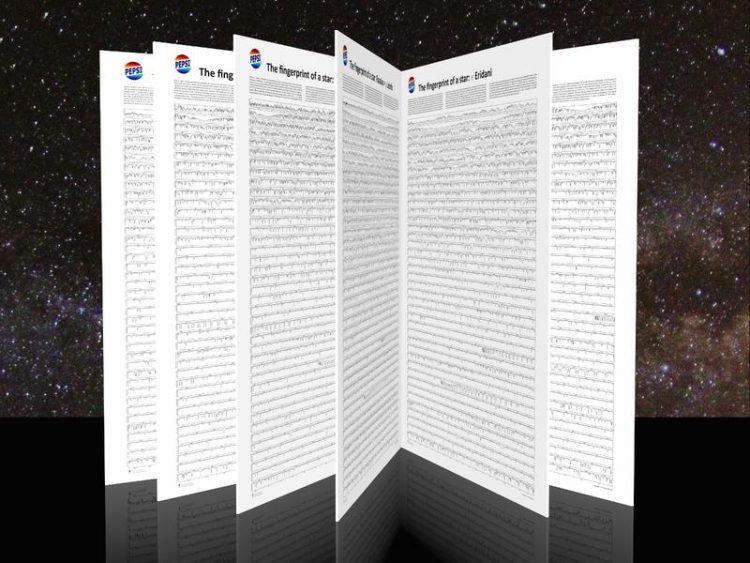First PEPSI data release

Visualization of a PEPSI atlas. AIP/K. Riebe, Spectra: PEPSI, Background: J. Rendtel
Spectral atlases are the fingerprints of stars and give insights into almost all of its physical properties like temperature, pressure, velocities and chemical composition. The first paper contains a new spectral atlas of the Sun and proves for the first time that a night-telescope instrument can reach a quality comparable to a specialized solar instrument.
All solar and stellar spectra were taken with an unprecedented spectral resolution of λ/Δλ=250,000, a resolution equivalent to a 1/100th of the diameter of a hydrogen atom (λ being the wavelength and Δλ the smallest measurable separation of two wavelengths) and cover the entire optical and near-infrared light (from 383 to 914nm).
For the Sun several spectral time series with up to 300 individual spectra per day were pre-analyzed and are also provided to the community. “These data recover the well-known solar 5-minute oscillation at a peak of 3 mHz (5.5min) from the disk-averaged light with a radial-velocity amplitude of only 47 cm/s, an incredibly small velocity from a stellar point of view”, says Prof. Strassmeier, PEPSI principal investigator and director of the Cosmic Magnetic Field branch at the Leibniz Institute for Astrophysics Potsdam (AIP).
The new atlas was also used to re-determine the abundance of Lithium in the Sun with very high precision. “Lithium is a key element for the nucleosynthesis in the universe and is also a tracer of mixing processes inside stars”, explains Dr. Matthias Steffen, one of the project scientists. Three-dimensional dynamic model atmospheres and a full statistical treatment of the spectral properties of the lithium atom were applied to determine the solar abundance.
The 48 stellar atlases in the second paper include the northern Gaia benchmark stars as well as other Morgan-Keenan standard stars. Spectra of these targets were not available at the given resolution and signal-to-noise ratio (S/N) before. The latter quantity represents the photon noise relative to the signal strength from the star and thus the quality of the spectra.
Previously available S/N for work on astrophysical parameters was typically several hundred at a spectral resolution λ/Δλ of at most 100,000. “PEPSI and the LBT provide S/N of several thousand at on average three times higher spectral resolution“, says Ilya Ilyin, PEPSI’s project scientist. “With such numbers we have now the typical daytime solar-like spectrum quality available also for bright stars at night time”, adds Strassmeier.
Finally, in the third paper, the star “Kepler-444”, hosting five sub-terrestrial planets, was confirmed to be 10.5 billion years old, more than twice the age of our Sun and just a little bit younger than the universe as a whole. The star is also found being poor on metals.
The chemical abundance pattern from the PEPSI spectrum indicates an unusually small iron-core mass fraction of 24% for its planets if star and planets were formed together. For comparison, terrestrial planets in the solar system have typically a 30% iron-core mass fraction.
“This indicates that planets around metal-poor host stars are less dense than rocky planets of comparable size around more metal-rich host stars like the Sun”, explains Claude “Trey” Mack, project scientist for the Kepler-444 observation.
AIP-scientists in the PEPSI project that led to the first data release include Michael Weber, Matthias Steffen, Silva Järvinen, Matthias Mallonn, Claude Mack, Thorsten Carroll, Carsten Denker, Sydney Barnes, Daniel Sablowski, Engin Keles, Ekaterina Dineva, Alessandro Mott, and Gohar Harutyunyan.
More information on PEPSI and the LBT:
https://pepsi.aip.de
http://www.lbto.org/
Online data viewer:
see “Library” at https://pepsi.aip.de
Original publications about the first data release in A&A:
K. G. Strassmeier, I. Ilyin, and M. Steffen, PEPSI deep spectra. I. The Sun-as-a-star, A&A, in press; arXiv:1712.06960
K. G. Strassmeier, I. Ilyin, and M. Weber, PEPSI deep spectra. II. Gaia benchmark stars and other M-K standards, A&A, in press; arXiv:1712.06967
C. E. Mack III, K. G. Strassmeier, I. Ilyin, S. C. Schuler, F. Spada, and S. A. Barnes, PEPSI deep spectra. III. A chemical analysis of the ancient planet-host star Kepler-444, A&A, in press; arXiv:1712.06986
Science contacts:
Prof. Dr. Klaus G. Strassmeier, 0331-7499-223, kstrassmeier@aip.de
Dr. Ilya Ilyin, 0331-7499-269, ilyin@aip.de
Christian Veillet (Large Binocular Telescope Observatory), +1 (520) 621-5286, cveillet@lbto.org
Media contact:
Dr. Janine Fohlmeister, 0331-7499-803, presse@aip.de
Media Contact
All latest news from the category: Physics and Astronomy
This area deals with the fundamental laws and building blocks of nature and how they interact, the properties and the behavior of matter, and research into space and time and their structures.
innovations-report provides in-depth reports and articles on subjects such as astrophysics, laser technologies, nuclear, quantum, particle and solid-state physics, nanotechnologies, planetary research and findings (Mars, Venus) and developments related to the Hubble Telescope.
Newest articles

First-of-its-kind study uses remote sensing to monitor plastic debris in rivers and lakes
Remote sensing creates a cost-effective solution to monitoring plastic pollution. A first-of-its-kind study from researchers at the University of Minnesota Twin Cities shows how remote sensing can help monitor and…

Laser-based artificial neuron mimics nerve cell functions at lightning speed
With a processing speed a billion times faster than nature, chip-based laser neuron could help advance AI tasks such as pattern recognition and sequence prediction. Researchers have developed a laser-based…

Optimising the processing of plastic waste
Just one look in the yellow bin reveals a colourful jumble of different types of plastic. However, the purer and more uniform plastic waste is, the easier it is to…


